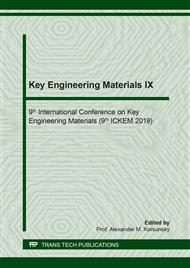p.81
p.89
p.96
p.103
p.111
p.118
p.125
p.131
p.137
Mechanical Properties of Ternary-Filled Natural Rubber Composites
Abstract:
The aim of this study was to investigate the effect of each ternary filler component: carbon black (CB), modified bentonite (M-BNT), and raw bentonite (BNT), and their interactions, on the mechanical properties of natural rubber (NR) composites, using a third degree-simplex lattice mixture design of experiment. The efficiency of the two-step organic modification to produce M-BNT was confirmed by the results of Fourier transform infrared with attenuated total reflectance (FTIR-ATR) spectroscopy and x-ray diffraction (XRD) analysis. Synergistic effect between CB and M-BNT on the mechanical properties of NR composites with ternary filler composition 10/5/0 was observed. Reinforcement of NR matrix using this ternary filler enhanced its tensile properties: strength (69.43%), modulus (47.01%), stress at 100% strain (34.67%), stress at 200% strain (41.88%), and stress at 300% strain (50.82%), as well as its compressive properties: strength (40.89%), modulus (40.05%), stress at 20% strain (41.10%), stress at 40% strain (37.57%), and stress at 60% strain (40.79%). Significant improvement in the mechanical properties was also attributed to the surface modification of M-BNT resulting to better dispersion to NR matrix. The addition of pure BNT filler resulted to lowest tensile and compressive performance due to high clay loading and incompatibility with NR matrix. Trends of the generated contour plots based on reduced hierarchical models demonstrated synergy between CB and M-BNT as well as deterioration of mechanical properties upon addition of pure BNT filler 0/0/15.
Info:
Periodical:
Pages:
111-117
Citation:
Online since:
September 2019
Authors:
Keywords:
Price:
Сopyright:
© 2019 Trans Tech Publications Ltd. All Rights Reserved
Share:
Citation:


